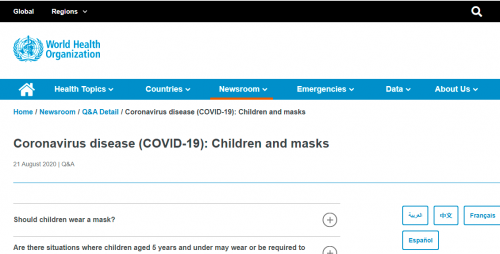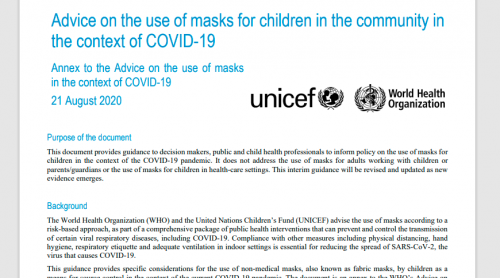
Yes, the World Health Organization has published its own recommendation for children wearing masks. It was released in August, just in time for school to return. There’s no way to describe this other than child abuse.
1. Other Articles On CV “Planned-emic”
The rest of the series is here. Many lies, lobbying, conflicts of interest, and various globalist agendas operating behind the scenes, obscuring the vile agenda called the GREAT RESET. The Gates Foundation finances: the WHO, the US CDC, GAVI, ID2020, John Hopkins University, Imperial College London, the Pirbright Institute, the BBC, and individual pharmaceutical companies. The International Health Regulations are legally binding. The media is paid off. The virus was never isolated, PCR tests are a fraud, as are forced masks, social bubbles, and 2m distancing.
2. Important Links
https://apps.who.int/iris/handle/10665/331693
April 6 WHO Guidance On Masks
https://www.who.int/emergencies/diseases/novel-coronavirus-2019/advice-for-public/when-and-how-to-use-masks
June 5 WHO Guidance On Masks
WHO On Forcing Masks On Children
August 21 WHO Guidance For Masks On Children
WHO On Masks: December 1 Update
December 1 WHO Guidance On Masks
Note: for more context for this article, check Part 37A, and Part 37B. They refer to the April 6, June 5 and December 1 guidelines handed down by the World Health Organization. In short, they still aren’t checking for logical consistency.
January 17, 2020 Testing Guidelines For WHO
March 19, 2020 Testing Guidelines For WHO
September 11, 2020 Testing Guidelines For WHO
September 11, 2020 WHO-2019-nCoV-Antigen_Detection
WHO: January, March, September 2020 Guidelines
WHO’s January 13, 2021 Posting On Test Guidelines
January 31 Global Surveillance For Human Infection
March 20 Global Surveillance For Human Infection
May 10 Global Surveillance For Human Infection
August 7 Global Surveillance For Human Infection
December 16 Global Surveillance For Human Infection
https://www.who.int/classifications/icd/Guidelines_Cause_of_Death_COVID-19.pdf
WHO Guidelines Classification Of Death
WHO Case Definition Guidelines
BCCDC: No Idea Actual Error Rate Of PCR Tests
BC COVID19_SerologyTestingGuidelines (1)
BC COVID19_InterpretingTesting_Results_NAT_PCR
Tricity: Bonnie Henry – False Positives Overwhelming Hospitals
CBC: Bonnie Henry Warning About False Negatives
WHO’s Definition Of “Herd Immunity”
WHO Posting On Herd Immunity Definition
WHO’s Other Definition Of Herd Immunity
3. Outline Of WHO Recommendation
Overview
This guidance provides specific considerations for the use of non-medical masks, also known as fabric masks, by children as a means for source control in the context of the current COVID-19 pandemic. It also advises on the use of medical masks for children under certain conditions. The document is an annex to the Advice on the use of masks in the context of COVID-19, in which further details on fabric masks can be found.
4. Frequently Asked Questions

Based on this and other factors such as childrens’ psychosocial needs and developmental milestones, WHO and UNICEF advise the following:
.
Children aged 5 years and under should not be required to wear masks. This is based on the safety and overall interest of the child and the capacity to appropriately use a mask with minimal assistance.
.
WHO and UNICEF advise that the decision to use masks for children aged 6-11 should be based on the following factors:
WHO and UNICEF advise that children aged 12 and over should wear a mask under the same conditions as adults, in particular when they cannot guarantee at least a 1-metre distance from others and there is widespread transmission in the area.
In general, children aged 5 years and under should not be required to wear masks. This advice is based on the safety and overall interest of the child and the capacity to appropriately use a mask with minimal assistance. There may be local requirements for children aged 5 years and under to wear masks, or specific needs in some settings, such as being physically close to someone who is ill. In these circumstances, if the child wears a mask, a parent or other guardian should be within direct line of sight to supervise the safe use of the mask.
WHO and UNICEF recommend masks for children as young as 6 years old. But even that is a bit misleading, as there are conditions where it is still expected. Considering all of the lies that go around with this “pandemic”, forcing kids to do this is cruelty.
5. WHO’s Publication For Masking Kids

[Page 1]
Background
The World Health Organization (WHO) and the United Nations Children’s Fund (UNICEF) advise the use of masks according to a risk-based approach, as part of a comprehensive package of public health interventions that can prevent and control the transmission of certain viral respiratory diseases, including COVID-19. Compliance with other measures including physical distancing, hand hygiene, respiratory etiquette and adequate ventilation in indoor settings is essential for reducing the spread of SARS-CoV-2, the virus that causes COVID-19.
This guidance provides specific considerations for the use of non-medical masks, also known as fabric masks, by children as a means for source control in the context of the current COVID-19 pandemic. The document is an annex to the WHO’s Advice on the use of masks in the context of COVID-191 in which further details on fabric masks can be found. This annex also advises the use of medical masks for children under certain conditions. For the purposes of this guidance, children are defined as anyone below the age of 18 years
Currently, the extent to which children contribute to transmission of SARS-CoV-2 is not completely understood. According to the WHO global surveillance database of laboratory-confirmed cases developed from case report forms provided to WHO by Member States and other studies, 1-7% of COVID-19 cases are reported to be among children, with relatively few deaths compared to other age groups 4-8. The European Centre for Disease Prevention and Control (ECDC) has recently reported the age distribution of COVID-19 among children in the European Union (EU), European Economic Area (EEA) and the United Kingdom (UK); theyreported that as of 26 July 2020, 4% of all cases in the EU/EEA and the UK were among children.
Evidence on the benefits and harms of children wearing masks to mitigate transmission of COVID-19 and other coronaviruses is limited. However, some studies have evaluated the effectiveness of mask use in children for influenza and other respiratory viruses. A study of mask wearing during seasonal influenza outbreaks in Japan noted that the use of masks was more effective in higher school grades (9-12 year old children in grades 4-6) than lower grades (6-9 year old children, in grades 1-3). One study, conducted under laboratory conditions and using non-betacoronaviruses, suggested that children between five and 11 years old were significantly less protected by mask wearing compared to adults, possibly related to inferior fit of the mask. Other studies found evidence of some protective effect for influenza for both source control30 and protection in children, although overall compliance with consistent mask wearing, especially among children under the age of 15, was poor.
Some studies, including studies conducted in the context of influenza and air pollution, found the use and acceptability of mask wearing to be highly variable among children, ranging from very low to acceptable levels and decreasing over time while wearing masks. One study was carried out among primary school children during COVID-19 and reported 51.6% compliance.
Several studies found that factors such as warmth, irritation, breathing difficulties, discomfort, distraction, low social acceptability and poor mask fit were reported by children when using masks. So far, the effectiveness and impact of masks for children during play and physical activity have not been studied; however, a study in adults found that N95 respirator and surgical masks reduced cardiopulmonary capacity during heavy exertion
[Page 2]
The benefits of wearing masks in children for COVID-19 control should be weighed against potential harm associated with wearing masks, including feasibility and discomfort, as well as social and communication concerns. Factors to consider also include age groups, sociocultural and contextual considerations and availability of adult supervision and other resources to prevent transmission.
There is a need for data from high quality prospective studies in different settings on the role of children and adolescents in transmission of SARS-CoV-2, on ways to improve acceptance and compliance of mask use and on the effectiveness of masks use in children. These studies must be prioritized and include prospective studies of transmission within educational settings and households stratified by age groups (ideally <2, 2-4, 5-11 and > 12 years) and with different prevalence and transmission patterns. Particular emphasis must be placed on studies in schools in low- and middle-income settings.
[Page 6]
Monitoring and evaluation of the impact of the use of masks in children
If authorities decide to recommend mask-wearing for children, key information should be collected on a regular basis to accompany and monitor the intervention. Monitoring and evaluation should be established at the onset and should include indicators that measure the impact on the child’s health, including mental health; reduction in transmission of SARS-CoV-2; motivators and barriers to mask wearing; and secondary impacts on a child’s development learning, attendance in school, ability to express him/herself or access school; and impact on children with developmental delays, health conditions, disabilities or other vulnerabilities.
The WHO and UNICEF released their “guidelines” over the summer for how and when children should be forced to wear masks. Although the official cut-off is 5 years old, they make it clear that toddlers under that age might be required to as well.
This is barbaric, and amounts to child abuse. If adults want to play along with this psy-op, that is their decision. However, it should never be imposed on youths. What kind of a sicko comes up with things like that?
